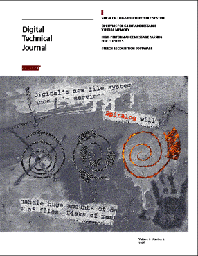
Jane C. Blake
Managing Editor
This past spring when we surveyed Journal subscribers, several
readers took the time to write comments about the particular value
of the issues featuring Digital's 64-bit Alpha technology. The
extraordinary engineering described in those two issues continues,
with ever higher levels of performance in Alpha microprocessors,
server systems, clusters, and systems software. This issue presents
some recent developments: a new log-structured file system, called
Spiralog; the OpenVMS operating system extended to take full advantage
of 64-bit addressable virtual memory; high-performance scientific
computing software for Alpha clusters connected with MEMORY CHANNEL;
and speech recognition software for Alpha workstations running
the Digital UNIX operating system.
Spiralog is a wholly new cluster-wide file system integrated with
the new 64-bit OpenVMS version 7.0 operating system and is designed
for high data availability and high performance. The first of
four papers about Spiralog is written by Jim Johnson and Bill
Laing who set the stage by introducing log-structured file concepts,
the university research on which the designers drew, and innovations
in the overall design.
The advantages of log-structured file technology over the conventional
"update-in-place" file technology are explained by Chris
Whitaker, Stuart Bayley, and Rod Widdowson. In their paper about
the file server design, they compare the Spiralog implementation
of the log-structured file technology with others and describe
the novel combination of the technology with a B-tree mapping
mechanism to provide the system with needed stability and data
recovery guarantees.
A third paper about Spiralog, written by Russ Green, Alasdair
Baird, and Chris Davies, addresses a critical customer requirement
--- fast, application-consistent, on-line backup, i.e., continuous
availability of data. Exploiting the features of log-structured
storage, designers were able to combine the best of two backup
approaches: the flexibility of file-based backup and the high
performance of physically oriented backup. Consistent copies of
the file system are created while applications are actively modifying
data.
The Spiralog integration into the OpenVMS file system required
that existing applications be able to run unchanged. Mark Howell
and Julian Palmer describe the integration of write-back caching
which used in Spiralog into the write-through environment used
in the existing Files-11 file system. They also define the function
of a write-behind cache, which allows applications to control
the order of writes to the disk.
The importance of compatibility for existing 32-bit applications
in a 64-bit environment is stressed again in the set of three
papers about the latest step in the evolution of the OpenVMS operating
system. Digital first ported the 32-bit OpenVMS operating system
to the Alpha architecture in 1992. The extension of the system
to exploit 64-bit virtual addressing is presented by Mike Harvey
and Lenny Szubowicz. Their discussion includes the team's solution
to significant scaling issues which involved a new approach to
page-table residency within the OpenVMS address space.
The OpenVMS development team anticipated that applications would
mix 32- and 64-bit addresses, or pointers, in the new environment.
Tom Benson, Karen Noel, and Rich Peterson explain why this mixing
of pointer sizes is expected and the DEC C compiler solution they
developed to support the practice. In a closely related discussion,
Duane Smith's paper reviews new techniques the team used to analyze
and modify the C run-time library interfaces that accommodate
applications using 32-bit, 64-bit, or both address sizes.
Designed for the scientific/technical user, the parallel-programming
tool next described does not run on the OpenVMS Alpha system but
instead on Digital UNIX Alpha clusters connected with MEMORY CHANNEL
technology. Jim Lawton, John Brosnan, Morgan Doyle, Seosamh O'Riordain,
and Tim Reddin present the challenges encountered in designing
the TruCluster MEMORY CHANNEL Software product, which is a message-passing
system intended for builders of parallel software libraries and
implementers of parallel compilers. The product reduces communications
latency to less than 10 microseconds in distributed shared memory
systems.
Finally, Bernie Rozmovits presents the design of user interfaces
for the Digital Speech Recognition Software (DSRS) product. Although
the product is targeted for Digital's Alpha workstations running
the UNIX operating system, the implementation issues examined
and the team's efforts to ensure the product's user-friendliness
can be generally applied to speech recognition product development.
Coming up in the next issue are papers on a variety of topics,
including the internet protocol, collaborative software for the
internet, and high-performance servers. These topics reflect areas
of interest Journal readers rated near the top in last spring's
survey. Our sincere thanks go to everyone who responded to that
survey.
|